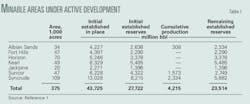Chinese oil companies invest heavily abroad
Chinese oil and gas companies have boosted their investments abroad since 2008 despite the global economic downturn, having committed billions of dollars into developing large fields in the Middle East and elsewhere.
"Looking ahead, the Chinese oil and gas companies will undoubtedly continue their aggressive investments in oversea oil and gas assets, either through corporate acquisitions or bidding rounds," said a January brief from FACTS Global Energy, based in Singapore.
Liutong Zhang and Kang Wu wrote the brief entitled "China's Overseas Oil and Gas Investment."
They said China's equity (net) oil production from its overseas operations in 2008 was 900,000 b/d. Although less that half of that actually reached China, the overseas production volume accounted for 25% of China's total crude oil imports, 23% of domestic oil production, and 12.5% of oil consumption.
Chinese companies' net oil production abroad is expected to reach 1.2 million b/d this year. The FACTS analysts forecast China's net overseas oil production at 1.7 million b/d by 2015 and 2 million b/d by 2020.
"With a flat domestic production, by 2020 the overseas equity oil could account [for] half of China's domestic oil production," they said.
CNPC abroad
China National Petroleum Corp. is the biggest investor among Chinese companies since late 2008. CNPC and its subsidiary, PetroChina Co. Ltd., currently are involved in more than 90 overseas projects, of which 65 involve oil or gas production and development.
Their 2008 net oil production from production outside China was 612,000 b/d of oil and 450 MMscfd of gas.
CNPC also has invested to build pipelines to import oil and gas from overseas, and it moved toward its goal of becoming an international company by buying Singapore Petroleum Co. (see Table 1).
The company and its subsidiaries hold stakes in oil and gas assets in 27 countries and provide field services, engineering, and construction in 49 countries worldwide.
CNPC-PetroChina concentrated their overseas investments in Africa, central Asia, Latin America, and the Middle East.
China National Offshore Oil Corp. (CNOOC) follows CNPC-PetroChina in its overseas investment while China Petroleum & Chemical Corp. (Sinopec) is third among Chinese companies in its international holdings.
In addition, state oil trading company Sinochem Group has begun investing abroad. Separately, the State Administration of Foreign Exchange and China Investment Corp. (CIC) also are acquiring interests in overseas ventures.
"There is no doubt that CNPC-Petrochina, CNOOC, Sinopec, and Sinochem have become important players in the global merger and acquisition market," FACTS said. "Nonetheless, the Chinese oil companies suffered a series of setbacks in 2009."
The Libyan government blocked CNPC International Ltd.'s proposed $499 million (Can.) takeover of Verenex Energy Inc. of Calgary. Instead, the Libyan Investment Authority, a sovereign wealth fund, acquired Verenex for $316 million (Can.).
Elsewhere, Angola's Sonangol reportedly moved to block Sinopec and CNOOC from obtaining deepwater acreage, FACTS analysts said.
Diverse investments
China's oil and gas companies, particularly CNPC-PetroChina, have signed several preliminary agreements and memorandums of understanding outlining billions of dollars in future investments (see Table 2).
CNPC is heavily involved in Iran and Iraq. FACTS attributed CNPC's ability to invest in Iran to the US sanctions keeping US-based oil companies away from investing there.
On Jan. 14, 2009, CNPC signed a buyback binding contract with National Iranian Oil Co. (NIOC) to develop onshore North Azadegan oil field. Duration of the agreement is 25 years. CNPC also has an MOU with NIOC to develop South Azadegan oil field.
Under the MOU, CNPC will take a 70% interest in South Azadegan while NIOC keeps a 20% share and Japan's Inpex owns 10%.
FACTS said the project reportedly will need up to $2.5 billion worth of investments, of which CNPC is expected to pay $2.25 billion and Inpex is to pay the rest.
"If the deal is successfully concluded, it will consolidate CNPC's interest in developing the Azadegan structure," FACTS said. "Azadegan is Iran's largest oil discovery in 30 years with estimated reserves of more than 30 million bbl."
Azadegan is close to the Iraqi border and has a complex geological formation, making the project both a strategic priority and an enormous technical challenge for Iran, FACTS said.
CNPC-PetroChina, already heavily involved in Kazakhstan and Turkmenistan, is looking to invest more in Russia, both in upstream and in pipelines.
In October 2008, CNPC and Transneft agreed to build a 300,000-b/d oil pipeline from East Siberia to China. On Apr. 27, 2009, Transneft launched construction of an offshore section from the East Siberia-Pacific Ocean to the Chinese border, just under 43½ miles. CNPC will build the remaining 609-mile stretch of pipeline.
Although not officially confirmed by the companies, FACTS said the estimated cost of the pipeline is $800 million.
Russia and China also plan cooperative gas pipeline projects. FACTS analysts said Russia reportedly reached an initial agreement in 2009 to supply China 6.76 bscfd, "which seems on the high end, given the capacity of the planned gas pipeline," adding, "It is expected that the gas fields in Siberia could be put into operation after 2015."
Chinese loans
The China Development Bank (CDB) last year signed a long-term agreement with CNPC in which CDB loaned CNPC $30 billion during 5 years to accelerate CNPC's globalization strategy of being an international operator in both upstream and downstream, FACTS said.
In addition to buying assets, China has offered $57 billion total in loans to several producing countries. China introduced the concept of loans for oil in 2004 by providing Angola with a $4 billion oil-backed loan for energy, infrastructure, and other projects.
Subsequently, China made a series of loans to Angola, which exports about 40% of its crude production to China.
China also has made loans to companies in Venezuela, Russia, Kazakhstan, Brazil, Turkmenistan, Bolivia, and Ecuador in exchange for long-term oil and gas supplies.
"Those countries could repay the loan through revenues from oil sales by selling upstream assets to Chinese oil and gas companies or through supplying crudes to China," FACTS said. "It is very likely that Chinese leaders will be able to negotiate a good return on their investment in future loans for oil and gas deals."
China also is building goodwill by providing capital to producing countries, analysts said.
The motivation for Chinese oil and gas companies to expand abroad is to take advantage of the Chinese government's concerns about security of energy supply, FACTS said. "Though the Chinese government actively encouraged overseas investment in the past, CNPC-PetroChina, Sinopec, CNOOC, and Sinochem are taking the lead today," FACTS said.
Other Chinese companies are interested in making overseas oil and gas investments, FACTS said, adding these smaller companies include ZhenHua Oil Co. and China Aviation Oil.
In late 2009, Shaanxi Yanchang Petroleum signed a production-sharing contract with New Energy Chemical Investment Group of Thailand to explore and develop gas Block L31/50, covering 3,960 sq km.
Yanchang Petroleum also has a production-sharing contract with Cameroon's government to explore the Zina and Makari blocks, which cover 3,862 sq km and 4,644 sq km, respectively. Yanchang Petroleum plans to spend $60 million during a 7-year exploration period, FACTS said.
More Oil & Gas Journal Current Issue Articles
More Oil & Gas Journal Archives Issue Articles
View Oil and Gas Articles on PennEnergy.com


